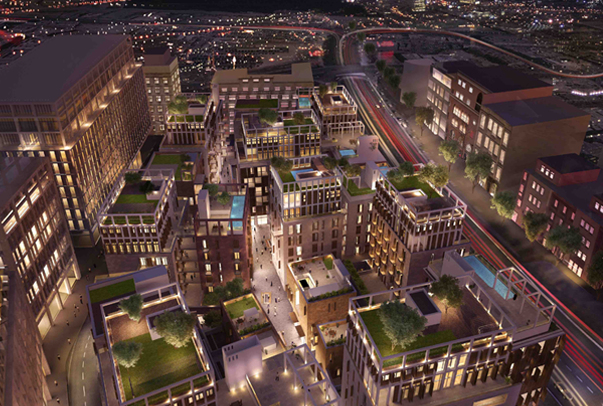District // S A city within a City
Described as a “city within the City”, District //S is transforming one of Beirut’s most sought-after locations; it features 22 buildings and encompasses 101 apartments; 18 studios; 4 townhouses; 8 penthouses; 41 retail units; a piazza; swimming pools; gardens; a cultural centre and more.
One of the main aspirations of District //S is to produce a real slice of urbanity that contributes to the intense life of a city like Beirut. Conceptualizing such a project takes a lot of hard work but managing to do justice to a city like Beirut is an overwhelming challenge. Careful planning and research, both on site and off, are at the core of the project’s success, whereby different elements are thoroughly considered to bring District //S to life.
Casual, yet thoroughly planned
The space in-between buildings is almost more important than the buildings themselves. District //S reinterprets key aspects of the urban spaces found in cities along the Mediterranean, known for the relaxed informality of their urbanism. Buildings are placed against each other in an almost casual way, giving shape to the most exciting and interesting spaces: little alleys, pocket piazzas and gardens.

An open community
District //S aspires to re-create a fragment of the Beirut city life; in order to do so, connectivity to the surrounds is a key consideration. Rather than understanding District //S as a gated community that shuts itself off from the city, the project seeks to embrace its surroundings and fit in the Mediterranean and Lebanese culture of community living.
The composition of buildings
With few exceptions, all buildings in District //S share the same simple and straightforward shape. All buildings in District //S are built from the same restrained palette of materials. And yet, every single building is unique.
The base of the buildings embodies public space and articulates the commercial uses that cover most of the ground floor. The main body contains the bulk of the residential space. Typically 5 floors of flats are stacked, creating calm and rigorous order. The top of the buildings are either roof gardens or penthouses, which are conceived as eight distinctive ‘jewels’ located in strategic positions.
Rich Architecture
The architecture of District //S is a modern interpretation of several aspects of Beirut’s traditional architecture. Avoiding generic answers the solution is completely site specific, taking into consideration different aspects of local culture in the design of each building and the proximity and areas between the buildings. It responds to the topography and the climate recreating stone balconies, raised gardens, arcades, loggias and a superb skyline.
An Animated Skyline
From very early on, the scheme aimed to create a dynamic skyline, rather than having one of consistent height. Considerable effort has been made to introduce changes in height that will animate the skyline, right down to the careful selection of the penthouses’ locations. Due to the site’s natural slope, the buildings will effectively terrace down from the south to the north.
Outdoor Living
In Mediterranean cultures, a great deal of social life happens in protected outdoor spaces: traditional architecture consists of courtyards, terraces, and verandas. The first step in managing District //S has been to establish the outdoor space, comprising a piazza, lanes and gardens, and which sets up the base for all the built mass on top and is a continuation of the indoor space, following the Mediterranean tradition. The main piazza is at the heart of the project, creating a generous open space with restaurants and cafes. The green spaces extend to the majority of the project and are mainly organized around three dominant types of gardens: a main public garden, a series of elevated gardens at the first floor level, and roof gardens at the penthouse level.
District //S represents an urban, site-specific solution within the centre of the Beirut. It has succeeded in creating a city spirit while remaining contemporary and unique; “a city with a soul”, it is truly a Lebanese answer, a Beirut-driven answer.

